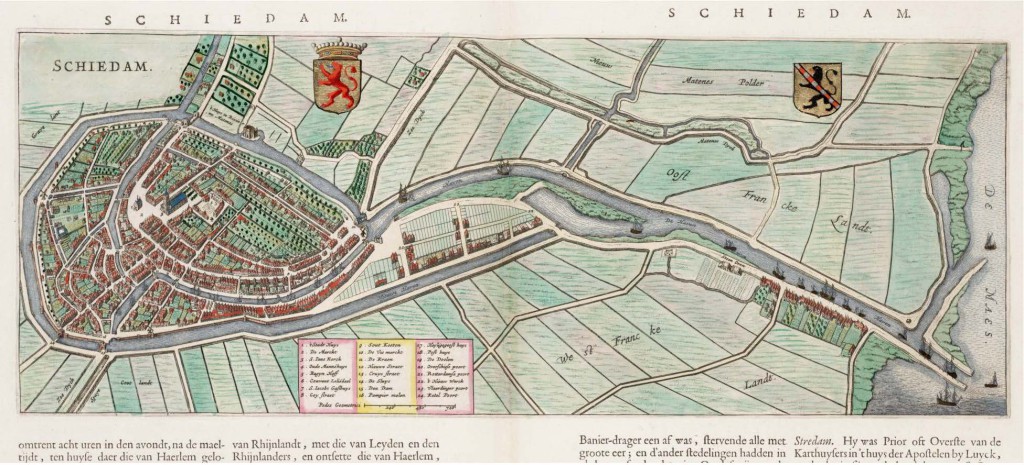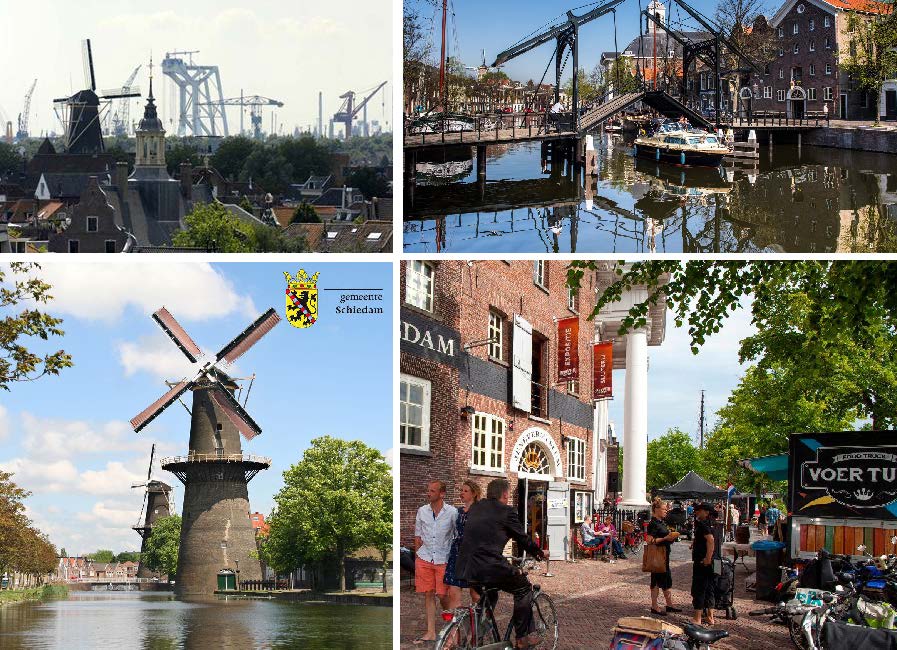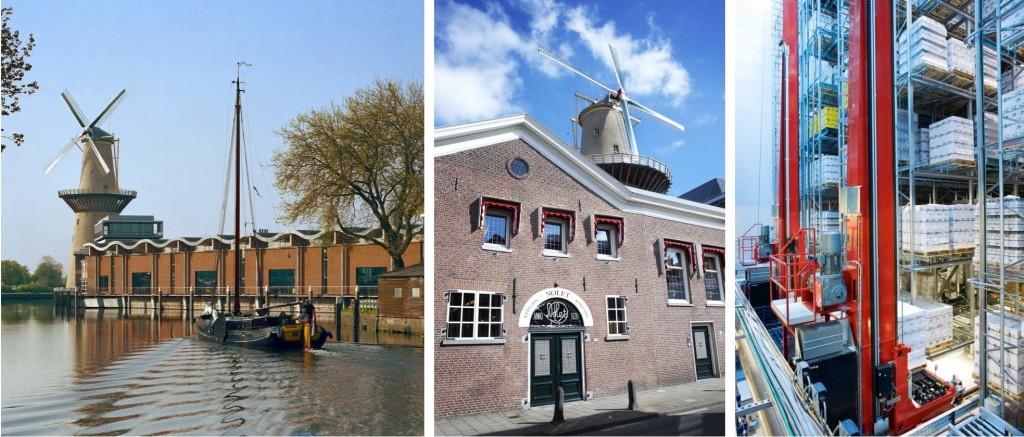Schiedam is a small port-city, with about 80.000 inhabitants in the Rotterdam area. Its current port is a functional part of the greater Port of Rotterdam.
Schiedam was founded in Rotterdam; around the year 1230 the river Schie was dammed to protect the land against the seawater. The dam attracted many trade activities because goods for and from the hinterland (Delft, and further away Leiden and Haarlem) had to be transhipped over the dam. In those days lock technology was non-existent and ships had to be lifted over the dam.
Images showing the map of Schiedam in the year 1649. (Courtesy of the Dutch National Maritime Museum)
A small town developed swiftly around the dam and its activities. In the year 1275 Schiedam received city rights from Lady Adelaide, this in her capacity as sister of William II, the reigning Count of Holland. She ordered the building of a castle near the Schie, which is known till today as the “Castle Mathenesse” (Dutch: “Huis te Riviere” or “Slot Mathenesse”). Remnants of a donjon, which were once part of the castle, are still visible today in the centre of Schiedam and near the city office.
As a young settlement Schiedam soon got competition from surrounding towns and cities: in 1340, Rotterdam and Delft also were allowed to establish a connection between the Schie and the Meuse. From the 15th century on the city flourished as a place of pilgrimage on the devotion around Saint Lidwina, one of the most famous Dutch saints who lived her life in Schiedam. The city gained subsequently significance by fishing for herring. In 1428 a great city fire swept through Schiedam, thereby destroying large parts of the then wooden city.
The 18th century was Schiedam’s Golden Age. Around 1700, cloth manufacturing and herring fishing finally gave way to the malt wine industry. In its heyday, 392 roasting houses, distilleries and mills were active. Schiedam Geneva (or Dutch Geneva-gin) was exported all over the world. The old port of Schiedam was an important asset for the export and the supply of grain. The Geneva industry was the town’s main industry during the early Industrial Revolution in the 18th and 19th century. During this time, the large mills were built, which ground the grain for the malt houses. There were more than 30 windmills in Schiedam. In order to catch sufficient wind and for a larger storage and production capacity, the mills grew to become the tallest in the world. The remaining giants from that time are still characteristic of the city. They have determined the Schiedam’s skyline for hundreds of years.
(a) The industrial port in the background. (Courtesy of the Municipality of Schiedam/S’Dam) (b, c, d) The centre of Schiedam with the old port, windmills and Geneva Museum. (Courtesy of the Gusto MSC company)
The city of Schiedam and its port have a long history. Its current form and function have roots in the shipbuilding industry of the 19th century. The first shipbuilding wharf was built by the Gusto company in 1905. The present port of Schiedam was founded in 1916 and was given its current layout in 1922. The first activities in the port were directed at shipbuilding and ship repairs. In 1924, the company Maatschappij voor Scheeps – en Werktuigbouw Fijenoord developed the Wilton port and in 1929 it established the Wilton-Fijenoord shipyard. The comprehensive shipyard grounds -a surface of approx. 100 hectares- included dry docks and (until 1980) even a golf course next to the historic villa, for use by Wilton-Fijenoord’s board of directors. After World War II, maritime companies underwent rapid expansion in Schiedam. As a consequence of cheap production costs in other countries, however, these industries declined in the 1970s and 1980s, initiating a period of neglect of the port. Although the major companies disappeared, technical maritime knowledge lived on in the city’s DNA. Some of the technicians who had been made redundant started their own companies and remained in Schiedam.
At the beginning of the 21st century, politicians from the municipalities of Schiedam and Rotterdam were expecting the maritime companies in Schiedam to move to the newly developed industrial port Maasvlakte II, which was closer to the sea, with more space and deeper berths. There were even plans to develop part of the Schiedam port into a housing zone. The historic buildings in the port would have been converted into housing projects. Such projects are very popular in Holland, because of the attractiveness of historic buildings with notable architectural detailing. However, at the end of the last century, instead of moving to the port extension Maasvlakte II, new offshore companies moved to Schiedam. The offshore companies were booming because of high oil prices. The port of Schiedam acquired the character of an expertise-intensive maritime hub boasting the presence of offshore-related head offices and major engineering agencies such as Huisman, GustoMSC, RH Marine, SBM Offshore and Mammoet. Not a single Schiedam port company moved to Maasvlakte II. After a few years of intensive acquisition, city and port authorities concluded that highly skilled workers preferred to work near the city, close to amenities. The financial crisis of 2008 put an end to housing plans in the port.
By 2014, the historic port facilities had become an asset. Port companies expressed an interest in intensifying their activities and building new docks. Like most ports, however, the port of Schiedam is surrounded by the city, leaving very little space for expansion. The port’s activities and the port traffic from the surrounding region are causing health problems for Schiedam’s residents. Moreover, the port’s quays are in poor condition. The Schiedam maritime companies asked the municipality to facilitate their investment plans and safeguard their future in the port; they stressed the need for comprehensive area development. They made their request mainly to the municipality, because the municipality owns almost all the terrain and is responsible for zoning. The port companies have long-term lease contracts. Moreover, the port companies were reluctant to start discussions with representatives of the residents of the nearby dwellings, due to lack of mutual trust. They preferred to leave this task to the municipality.
The municipality started the planning process with an empty map of the port and asked the port companies to draw up plans to accommodate their ambitions and develop solutions for the traffic and environmental problems. A major problem of the site was the use of the former golf course as a sludge depot. The site had to be cleaned up before it could be redeveloped into a new industrial zone. This would generate the opportunity to move the most environmentally problematic port activities away from the residential properties surrounding the port. The plans and ideas were compiled in an ’ambition map’ for the port of Schiedam. Throughout this process a wide range of maritime companies, local inhabitants, environmental groups, city council members, universities and government bodies were consulted and their ambitions included in the map, in close collaboration with all stakeholders. The preservation and renovation of several historic buildings were among the ambitions represented.
In 2015, the state, regional and local government, port authorities, universities and all the companies signed a letter of intent to develop the plan further. In February 2018, the Municipality of Schiedam signed a vital collaboration agreement with the Port of Rotterdam in February 2018, aimed at strengthening the port’s accessibility and sustainability. This resulted in a comprehensive investment programme with a robust volume of 22 million euro. This programme is currently being implemented in close collaboration with businesses, the Port of Rotterdam and the Municipality of Schiedam. The investment programme targets the improvement of sustainability and accessibility through the upgrading of infrastructure, improvement of public transport, installation of boarding points for water buses and water taxis, and the development of a cycle path network. These spatial interventions are paired with various forms of collaboration in the field of technical education, expertise and innovation, all of which will contribute to the safeguarding of a healthy living environment, good amenities and historical sites connecting the city to the port, and the future to the past.
Due to extensive branding and acquisition, important new maritime companies have started to arrive in Schiedam: RH Marine, FMJ electronics, Vryhof Anchors, Navingo and new offices from Damen Shipyards. In 2018 the offshore cluster in Schiedam received a new name: Offshore Valley. Offshore Valley now boasts more than 50 renowned offshore businesses and 2,000 maritime engineers. This innovation has gone hand in hand with historic preservation. In a recent essay, Schiedam: a maritime hotspot with great potential, Bart Kuipers from Erasmus University of Rotterdam concluded that “It is quite remarkable that the port area has not fallen prey to residential building, but instead has experienced revival and renewal as a high-performance maritime cluster. The Port of Schiedam is a maritime hotspot with the profile of an innovative and high-quality entrepreneurial environment for the maritime manufacturing industry and service provision. This is strongly related to the port’s history” [1].
In the port of Schiedam there are several historic buildings that are owned by powerful companies. The companies themselves have decided to restore the buildings. Beyond the investment in the overall development of the area, there was no specific public investment into the preservation of heritage buildings. The municipality did however invest more than € 13 million in the restoration of the quays in the old port of Schiedam. In its turn this lead to considerable restorations of private buildings in the vicinity of the old port. The municipality is working to make its citizens and companies conscious of its maritime history, trough publications, exhibitions in the municipal museum and the celebration of de 100 year anniversary of the port.
GustoMSC building
A monumental historic Wilton Fijenoord- carpentry factory located in the most western part of the site today hosts the engineering company GustoMSC. The three-story factory built in 1948 extends over an area of 9500 m2. The architectural office JHK’s architects from Utrecht designed the restoration. The building consists of different open and closed office spaces, meeting and consultation areas and a central meeting space. All these rooms are positioned around an atrium. In this way the atrium is the centre of attention. Big stairs connect the multiple floors. The original concrete construction is optimized for its current needs and its open space preserved. The restoration won a Fenix Award in 2016.
Images showing the GustoMSC building’s interior and exterior views. (Courtesy of the GustoMSC company).
Nolet Distillery
The Nolet Distillery, which was established in 1691 in Schiedam, and now led by the 10th and 11th generation Nolet family, opted to build a new windmill in a historic style during a larger renovation and expansion endeavour. Historically, the city of Schiedam hosted some 24 windmills, of which 19 grinded for the Geneva (or Dutch Geneva-gin) production. Only seven of the traditional ones remain. The new mill, finished in 2006, is not a heritage site and does not grind malt, but it takes on the look of a traditional tower windmill with so-called ‘Dekkerwieken’. Instead, it generates electricity for the distillery. The sails are equipped with a specially developed system (co-signed by Delft University of Technology), adapted to the structure’s unusual function. The windmill works automatically, which makes the presence of a miller unnecessary. The internal area hosts a reception area, a theatre, and gathering spaces. The historical reference enriches the Schiedam port area. Just as new functions build upon old port facilities, the newly built windmill connects to the long history of the site.
Images showing the Nolet windmill, as well as the renovated factory – buildings and the modern production line with “Kethel one” Geneva. (Courtesy of Nolet-Company).
The Wilton Villa
The Wilton Fijenoord company is now situated in the Wilton Villa in Schiedam. The company does not build ships anymore and is now dedicated to trading spare parts, logistic support, technical support and advises and after sale services for the ships the company built in the past. The Villa was built in 1922, the architect was A. Nolet. Until the 1980’s the villa was used as a representative building for special occasions and meetings with customers from all over the world for the Board of the Wilton Fijenoord company. The private golf course on the Wilton premises was closed down and was turned into a depot for sludge extracted when deepening the Wilton harbour. As from 1999 the Wilton Villa serves as the regular office for the company. Around 2014 the villa has been restored, whereby its original state and its authentic character was maintained or brought back, combined with modern facilities to accommodate the employees. The villa still contains beautiful paintings and ship models of the past. All the details of the past are still in place, even the tableware with Wilton Fijenoord Logo is still in use. Wilton Fijenoord is now developing plans together with the municipality and port authorities to redevelop the sludge-depot into a high-end maritime industrial zone.
Aerial of the Wilton Villa; a view of the villa from the river and the board room. (Courtesy of the Wilton Fijenoord – company).
Conclusion
From the 13th century until now Schiedam has always been connected by the waterways tot the sea and the hinterland. Schiedam’s historical roots have helped redevelop the port. Through the ages Schiedam adapted to new developments, form making Geneva, to building ships and developing high tech innovations in energy transition.
The maritime companies are very resilient and have shown themselves through the ages capable in reinventing themselves. The financial crisis of 2008 forced the municipality to rethink the future of its port. After the municipality realised the importance and the resilience of the maritime cluster, it decided to support this industry with a comprehensive investment plan. This was only possible in a good collaboration between public and private sector.
It is important to make society conscious of its cultural heritage trough exhibitions and events. Investment in public heritage (restoring old quays, locks) stimulates investments in private heritage (company buildings). The maritime companies who own the historic buildings all have roots (DNA) in Schiedam and consider it important to maintain their cultural heritage. Conservation of heritage can go well together with high tech industry. Behind the beautifully restored walls of ancient buildings you can find the latest technologies and state of the art offices.
Note
[1] B. Kuipers “Schiedam a maritime hotspot with great potential”. https://offshorevalley.nl/the-future-of-the-port/?lang=en
References
B. Kuipers “Schiedam a maritime hotspot with great potential”.
https://offshorevalley.nl/the-future-of-the-port/?lang=en
Wilton-Fijenoord
https://www.revolvy.com/page/Wilton%252DFijenoord?stype=videos&reload=1&_=148618.
Wikipedia “History of Schiedam”.
https://en.wikipedia.org/wiki/Schiedam.
GustoMSC “Past, present and future, 150 years of heritage”.
Head Image: The centre of Schiedam with the old port. (Courtesy of the GustoMSC company)




